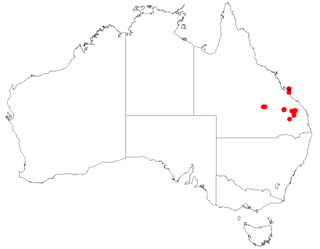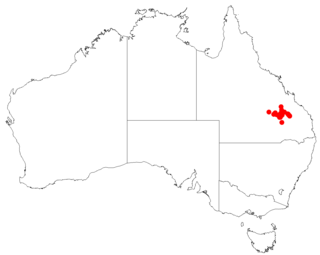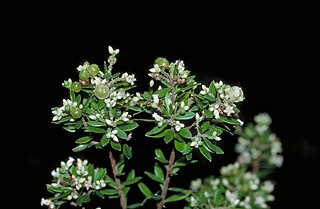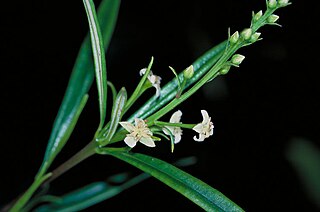
Leucopogon juniperinus, commonly known as prickly beard-heath, is a species of flowering plant in the heath family Ericaceae and is endemic to south-eastern continental Australia. It is an erect, densely-branched shrub with oblong to more or less egg-shaped leaves with the narrower end towards the base, and white, tube-shaped flowers arranged singly in upper leaf axils.

Styphelia ericoides, commonly known as the pink beard-heath, is a species of flowering plant in the heath family Ericaceae and is endemic to south-eastern Australia. It is a slender shrub with oblong leaves, and white to pinkish, tube-shaped flowers.

Styphelia fletcheri is a species of flowering plant in the heath family Ericaceae and is endemic to south-eastern continental Australia. It is a densely-branched shrub with sharply-pointed oblong leaves, and pendent, tube-shaped white flowers in pairs in upper leaf axils.
Pomaderris tropica is a species of flowering plant in the family Rhamnaceae and is endemic to Walshs Pyramid in north Queesland. It is a shrub with softly-hairy branchlets, egg-shaped to elliptic leaves and clusters of white to cream-coloured flowers.

Styphelia biflora is a species of flowering plant in the heath family Ericaceae and is endemic to eastern Australia. It is an erect to spreading shrub with hairy branchlets, oblong leaves and small white flowers.

Styphelia blakei is a species of flowering plant in the heath family Ericaceae and is endemic to inland southern Queensland. It is a sometimes prostrate, twiggy shrub with hairy branches, egg-shaped leaves with the narrower end towards the base, and small white flowers.

Styphelia clelandii, commonly known as Cleland's bearded-heath, is a species of flowering plant in the heath family Ericaceae and is endemic to the south-east of continental Australia. It is weak, open shrub with broadly egg-shaped leaves and white flowers arranged singly or in pairs in leaf axils near the ends of the branches.
Styphelia confertus, commonly known as Torrington beard-heath, is a species of flowering plant in the heath family Ericaceae and is endemic to a restricted part of New South Wales. It is a small shrub with erect, oblong or lance-shaped leaves, and white, tube-shaped flowers, the petals with shaggy hairs.

Styphelia cuspidata is a species of flowering plant in the family Ericaceae and is endemic to the central Queensland coast. It is a shrub with densely hairy young branchlets, egg-shaped to lance-shaped leaves with the narrower end towards the base, and white, bell-shaped flowers that are bearded inside.

Styphelia deformis is a species of flowering plant in the heath family Ericaceae and is endemic to eastern coastal Australia. It is a bushy shrub with narrowly egg-shaped leaves, and white, tube-shaped flowers.

Styphelia exolasia, commonly known as Woronora beard-heath, is a species of flowering plant in the heath family Ericaceae and is endemic to a small area of New South Wales. It is an erect shrub with oblong or elliptic leaves, and drooping, white, tube-shaped flowers.

Styphelia flexifolia is a species of flowering plant in the family Ericaceae and is endemic to south-east Queensland. It is a rigid shrub with many softly-hairy branchlets, crowded, sharply-pointed linear to lance-shaped leaves, and small, white, bell-shaped flowers that are bearded inside.

Leucopogon gelidus is a species of flowering plant in the heath family Ericaceae and is native to south-eastern continental Australia. It is a slender, compact shrub with elliptic to egg-shaped leaves, and spikes of drooping, tube-shaped white flowers.

Styphelia grandiflora is a species of flowering plant in the heath family Ericaceae and is endemic to Carnarvon National Park in south-eastern Queensland. It is a shrub with softly-hairy branchlets, oblong leaves and white flowers.

Leucopogon lavarackii is a species of flowering plant in the heath family Ericaceae and is endemic to Cape York Peninsula in far northern Queensland. It is a much-branched shrub with softly-hairy branchlets, oblong, elliptic or lance-shaped leaves and spikes of white, tube-shaped flowers.
Androcalva perkinsiana, commonly known as headland commersonia, is a species of flowering plant in the family Malvaceae and is endemic to a restricted part of central eastern Queensland. It is a small, erect shrub with hairy young branchlets, oblong or lance-shaped leaves with 5 to 11 pairs of small serrations on the edges, and groups of 3 to 4 pale purple flowers.

Leucopogon thymifolius, commonly known as thyme beard-heath, is a species of flowering plant in the heath family Ericaceae and is endemic to Victoria. It is a slender shrub with spreading, egg-shaped to oblong leaves and white to pale pink, tube-shaped flowers arranged in spikes of seven to thirteen in leaf axils, or on the ends of leafless branches.

Leucopogon virgatus, commonly known as common beard-heath, is a species of flowering plant in the heath family Ericaceae and is endemic to south-eastern Australia. It is an erect to low-lying shrub with linear to narrowly lance-shaped or egg-shaped leaves, and erect clusters of three to seven white, tube-shaped flowers on the ends of branches and in upper leaf axils.

Leucopogon yorkensis is a species of flowering plant in the heath family Ericaceae and is endemic to Cape York Peninsula in far northern Queensland. It is a shrub or tree with brown, fibrous bark, softly-hairy branchlets, lance-shaped or egg-shaped leaves with the narrower end towards the base, and spikes of small, white, tube-shaped flowers.

Ricinocarpos ledifolius is a species of flowering plant in the family Euphorbiaceae and is endemic to eastern Queensland. It is a monoecious or dioecious shrub or small tree with linear leaves and white flowers, arranged either singly, or with two or three female or two to six male flowers, or a single female flower surrounded by two male flowers.

















